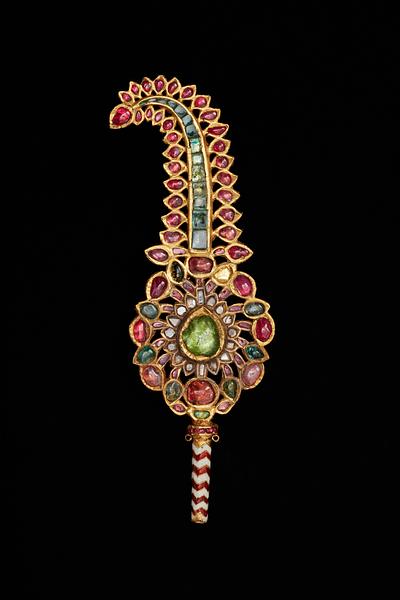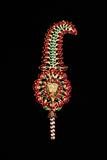Turban ornament, gold set with rubies, diamonds, and emeralds; enameled back
India, Jaipur or Murshidabad; 18th century
H: 17.5 cm
A turban ornament (sarpech) like this one was derived from the European aigrette, which came to India in the late 16th century. The form was initially reserved for the Great Mughal and his family, but as early as the 17th century, it was also bestowed on the great men of the realm, and in time its significance was watered down.
On the back, which is decorated with enamel to mimic the gems on the front, is a hoop that could hold a plume. Richly inlaid and enameled jewelry was made over a long period in India, something that can make it difficult to determine the date of individual pieces.
Inv. no. 2/1981
Published in:
Robert Skelton (ed.): The Indian heritage: court life and arts under Mughal rule, Victoria and Albert Museum, London 1982, cat.no. 310, p. 110;
Kjeld von Folsach: Davids Samling gennem 24 år, 1962-1985 = The David Collection: a 24-year period: 1962-1985, København 1985, pp. 70-71;
Kjeld von Folsach: Islamic art. The David Collection, Copenhagen 1990, cat.no. 384;
Kjeld von Folsach, Torben Lundbæk and Peder Mortensen (eds.): Sultan, Shah and Great Mughal: the history and culture of the Islamic world, The National Museum, Copenhagen 1996, cat.no. 341;
Jessica Hallett, Conceicao Amaral (eds.): Cultures of the Indian Ocean, Museu Nacional de Arte Antiga, Lissabon 1998, cat.no. 98, p. 297;
Kjeld von Folsach: Art from the World of Islam in The David Collection, Copenhagen 2001, cat.no. 591;


